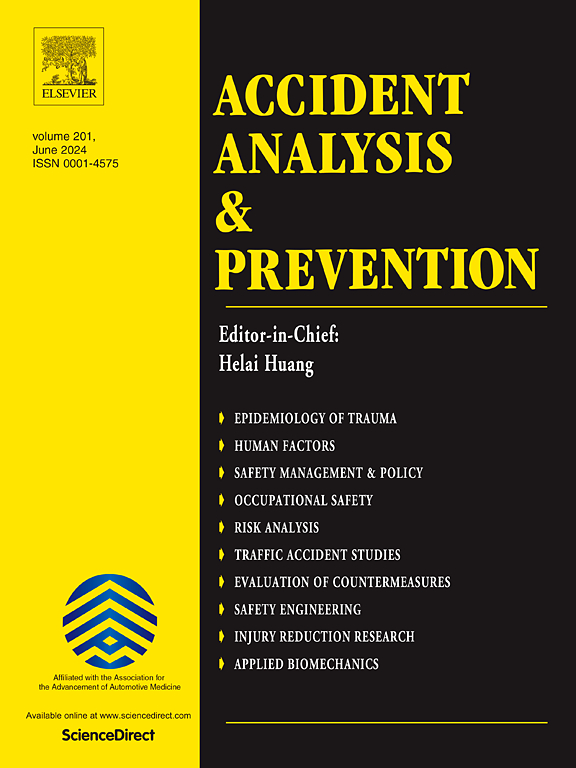Short-term safety analysis and interdependencies of mixed-operation freeways with fully separated express lanes: A copula-based poisson lognormal lindley approach
IF 5.7
1区 工程技术
Q1 ERGONOMICS
引用次数: 0
Abstract
The I-4 Ultimate Express Lanes (ELs) are part of a major improvement project on Interstate 4, introducing innovative freeway design that impacts traffic safety and operations. This research examines safety performance and the interdependencies between general-purpose lanes (GPLs) and (ELs). Utilizing crash data from February 2022 to February 2024, short-term crash frequency models are developed at the lane-level, leveraging microscopic traffic detector data and unique geometric design features to estimate annual average weekday crash frequencies and capture temporal safety variations. The study employs Poisson Lognormal Lindley (PLN-L) model to address excessive zeros in crash data, particularly prevalent in ELs, while copula-based framework analyzes the dependency between GPL and EL crash frequencies. Frank copula provided the best fit among five tested copula structures, revealing significant dependency, especially at access points. The analysis incorporates lane-level traffic characteristics, geometric data (e.g., standard and I-4 Ultimate specific segment types (interaction between ELs and GPLs at access points), their lengths, and ramp lengths), and time-period effects. Significant variables for GPL and EL segments include lane-level traffic exposure and other factors. Key findings indicate that the average lane-occupancy in the rightmost lane significantly impacts EL safety, with higher crash rates at merge segments. For GPLs, I-4 Ultimate segments and their shorter lengths (i.e., Long [5000ft >= (length) > 3000ft]) are associated with GPL-related crashes. These findings contribute to developing safer, more efficient managed lane systems and offer guidance for future freeway design improvements. The study gives policymakers and engineers insights into EL safety, design, and operation.
具有完全分离的快速车道的混合运营高速公路的短期安全分析和相互依存关系:基于 copula 的泊松对数正态林德利方法
I-4终极快速车道(ELs)是4号州际公路重大改进项目的一部分,引入了影响交通安全和运营的创新高速公路设计。本研究考察了通用车道(gpl)和通用车道(el)之间的安全性能和相互依赖性。利用2022年2月至2024年2月的碰撞数据,在车道水平上开发了短期碰撞频率模型,利用微观交通探测器数据和独特的几何设计特征来估计年平均工作日碰撞频率并捕获时间安全变化。该研究采用泊松对数正态林德利(PLN-L)模型来解决碰撞数据中过多的零,特别是在ELs中普遍存在,而基于copula的框架分析了GPL和EL碰撞频率之间的依赖关系。Frank copula在五个测试的copula结构中提供了最佳匹配,揭示了显着的依赖性,特别是在接入点。该分析结合了车道级交通特征、几何数据(例如,标准和I-4终极特定路段类型(接入点上el和gpl之间的相互作用)、它们的长度和坡道长度)以及时间段效应。GPL和EL段的重要变量包括车道级交通暴露和其他因素。主要研究结果表明,最右侧车道的平均车道占用率显著影响高速公路的安全,在合并路段的碰撞率更高。对于gpl, I-4终极分段及其较短的长度(即长[5000ft >;=(长度)>;3000英尺])与gpl相关的事故有关。这些发现有助于开发更安全、更高效的管理车道系统,并为未来的高速公路设计改进提供指导。该研究为决策者和工程师提供了关于高铁安全、设计和运营的见解。
本文章由计算机程序翻译,如有差异,请以英文原文为准。
求助全文
约1分钟内获得全文
求助全文
来源期刊

Accident; analysis and prevention
Multiple-
CiteScore
11.90
自引率
16.90%
发文量
264
审稿时长
48 days
期刊介绍:
Accident Analysis & Prevention provides wide coverage of the general areas relating to accidental injury and damage, including the pre-injury and immediate post-injury phases. Published papers deal with medical, legal, economic, educational, behavioral, theoretical or empirical aspects of transportation accidents, as well as with accidents at other sites. Selected topics within the scope of the Journal may include: studies of human, environmental and vehicular factors influencing the occurrence, type and severity of accidents and injury; the design, implementation and evaluation of countermeasures; biomechanics of impact and human tolerance limits to injury; modelling and statistical analysis of accident data; policy, planning and decision-making in safety.
 求助内容:
求助内容: 应助结果提醒方式:
应助结果提醒方式:


